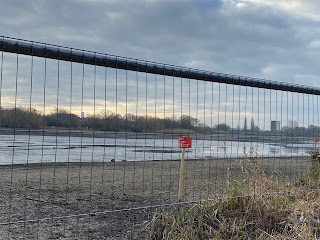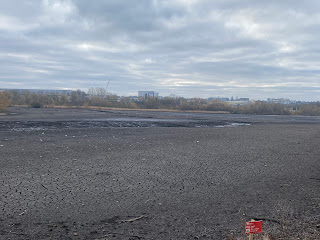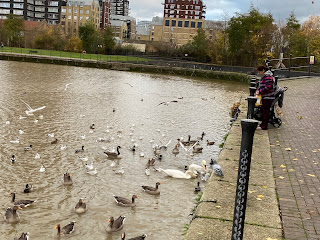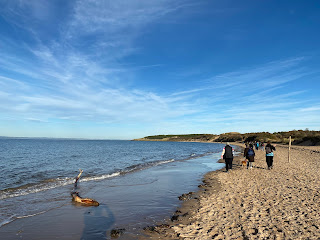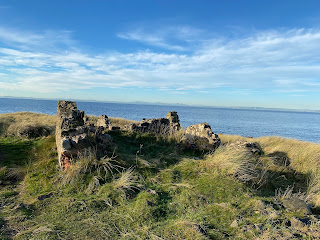Last month Allison and I went on holiday to Canada. We had a lovely time visiting friends and relatives in Manitoba and Ontario, saw the Northern Lights (a first-time sighting for me, and they were spectacular) — and I had the chance to get some birding in.
Birding in another country is always fun because it offers the (always exciting) chance to see birds I wouldn’t see at home. Birding on another continent takes it to another level!
That said, I got a good spot in before we even took off from Heathrow Airport. Glancing out of the window as the plane taxied towards the runway, I saw a female Kestrel hovering over the grass, mere yards from the tarmac.
In rural Manitoba I managed some good sightings, including a couple of lifers like White-crowned Sparrows and a lovely-looking Eastern Bluebird in addition to the birds I’ve seen there on previous trips — Blue Jays, Dark-eyed Juncos, American Crows and many, many Canada Geese. Most impressive was a Bald Eagle soaring overhead. My first thought was: “surely not?” — but as it turns out, it’s well within their range, and what else could it have possibly been? Another lifer!


To Ontario next, for a few relaxing days at the cottage in Muskoka. I was happy enough with the Common Loons on the lake (it doesn’t feel like a trip to the cottage without a loon sighting), but a family of swans (two adults and a cygnet) added another new species to my life list — they were Trumpeter Swans, a species native to North America. My Canadian field guide (DK’s Birds of Canada, published in 2005) suggested that Ontario is not in their range, but there has been a rewilding project involving these birds in the past few years in the Georgian Bay area. One of them even had a visible tag number — L55, for the record. Also seen was a Golden Eagle overhead — again, I was sceptical at first, but that was what it was. Size aside, you can tell by the primary feathers sticking out as it soars (not that I’d ever seen one before, but years of studying field guides has its rewards).



In Toronto, I spent a few hours walking around High Park. Located to the west of the downtown area, High Park is Toronto’s largest public park and has an outdoor theatre, a zoo, various sporting facilities, a museum and a few hiking trails.
It’s also great for birding. My walk around there yielded a total of 17 species — some of them European imports like House Sparrows and Mallards, but most of them native North American birds like Black-capped Chickadees, Dark-Eyed Juncos (lots of those), a couple of Hermit Thrushes and — as in Manitoba — a lone Blue Jay.
Best of all, though, was the fact that the Hawk Watch was going on atop the appropriately-named Hawk Hill, just north of the Grenadier Restaurant which was where I had an excellent lunch. The Hawk Watch is the observation of migrating birds of prey takes place in every day in High Park throughout autumn — Toronto being on most birds’ migration routes south (birds heading south tend to follow the shoreline when they get to Lake Ontario), and the hill in the middle of High Park being an ideal spot from which to watch them. It’s one of very few raptor monitoring sites to be located in an urban environment.
The friendly volunteers were happy to admit this foreigner into their midst and point out sightings that I’d other wise have missed: Sharp-shinned and Red-tailed Hawks, two-dozen Turkey Vultures and — repeating the Manitoba experience — a couple of Bald Eagles. There was also a Red-bellied Woodpecker that I would otherwise have had no chance of identifying.
Bird-related chat centres upon plans to rename any species that got named after an eighteenth- or nineteenth-century naturalist, a big project that’s not without its detractors; there are those who still aren’t happy with the Grey (or is it Gray?) Jay being officially renamed the Canada Jay back in 2018 (either way, I’ve yet to see one of these). Commenting on how many House Sparrows I’d seen, I mentioned that they were in decline back home — and was told that I was welcome to take some home with me!
After leaving the Hawk Watch people, I spotted a very small bird, in the restaurant car park no less. It looked like a Goldcrest but was in fact my first-ever Golden-crowned Kinglet, a close relative of our Goldcrest and one of the smallest passserines in North America.
All in all, my Canadian holiday yielded a total of thirty species, of which eight were lifers.




